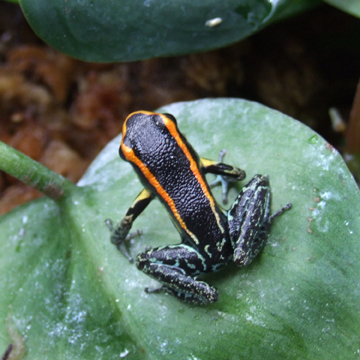Beautiful captive-bred poison dart frogs make great, low-upkeep pets. Stunningly colored, and beautifully patterned, these juvenile frogs are the perfect inhabitants in your naturalistic terrarium. And, like all captive bred dart frogs (and long term captive wild-caught specimens) they are not even toxic.

One of our favorites is the striking Dendrobates auratus Panamanian Green & Bronze morphs. These guys start out looking like standard Green & Black frogs, but as they reach maturity, the black fades to a metallic bronze brown. The green on these little guys ranges from bright lime to a metallic color I last saw on a 2008 Ford Mustang!
Then there are one of my all-time personal favorites,Hyloxalus azureiventris (formerly Cryptophyllobates azureiventris), the Sky Blue Poison Dart Frog. The belly and legs on these diminutive little guys is a beautiful sky blue with black reticulations. The juveniles have orange/yellow dorso-lateral stripes that will change to bright lemon yellow as they mature.

From one tiny geographic location in the Andes mountains of Peru, H. azureiventris is one of the rarest dart frogs in the pet hobby, although in captivity, they breed like rabbits. The only reason I can see for their rarity is they are not as brightly colored as other poison dart frogs, so are not as popular.
Last, but certainly not least, is the Big Kahuna of the dart frog hobby, Dendrobates tinctorius azureus.*
D. azureus has been a perennial favorite in the hobby, even though it wasn’t officially described until 1981. A number of factors have led to its popularity, certainly not the least of which is the absolutely striking coloration of this frog, an absolutely stunning royal blue with black reticulations.
Another factor leading to their popularity is the outgoing nature of azureus. Some dart frogs tend toward the shy end of the spectrum, but azureus isn’t one of them. As soon as I walk in the frog room, these guys start hopping over to the front of the tank looking for food.

And, man can they eat! These frogs will also get fairly large by dart frog standards, and can put away a lot of fruit flies.
*O.K., time to explain the whole azureus/tinctorius thing. In a nutshell, D. azureus lives in the wild in only one small patch of Suriname rainforest that is surrounded by dry, impassible (at least for a frog) savannah. Surrounding this savannah is more rain forest that is the home to the incredibly variable Dendrobates tinctorius species and its myriad color morphs. While azureus had originally been classified as a separate species, recent research seems to indicate that it really is just a separate color morph of tinctorius, which was separated from the rest of the species around the time of the last ice age. This separation provided for the development of a very distinct coloration, but not enough time for the actual genetic changes of speciation. Make sense?
Wait until I get into the rest of the new dart frog scientific nomenclature changes.